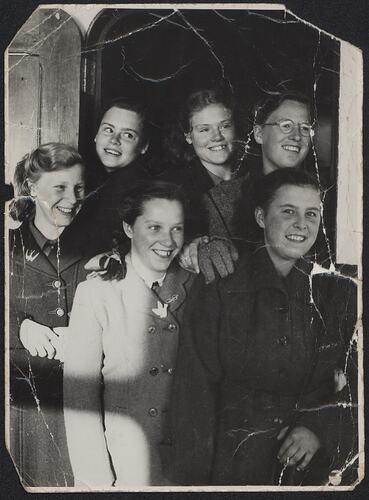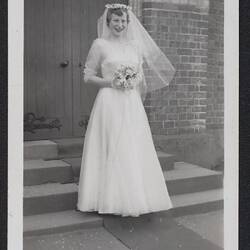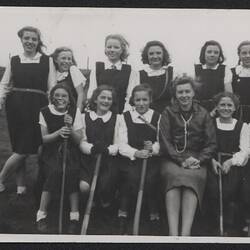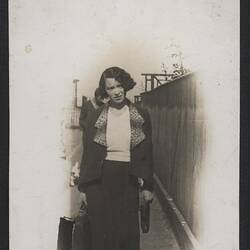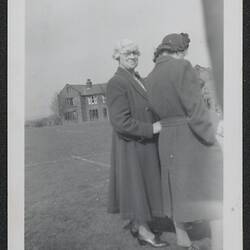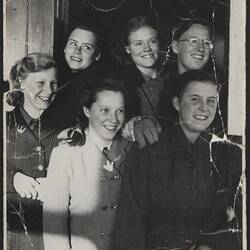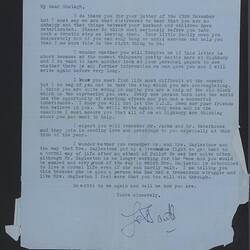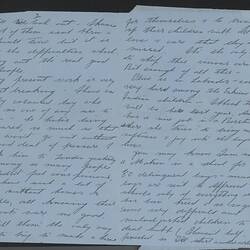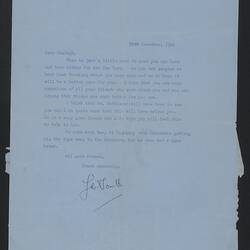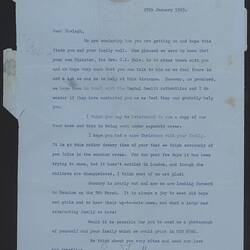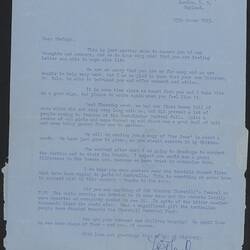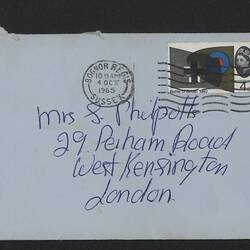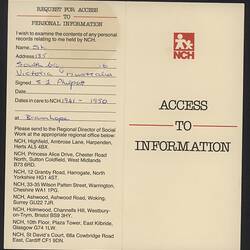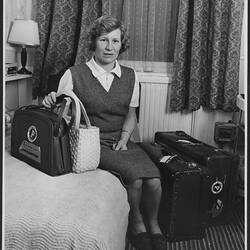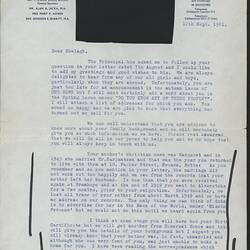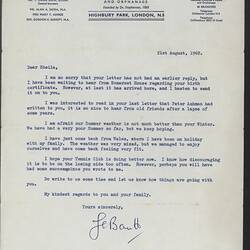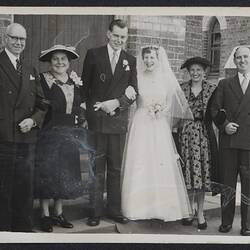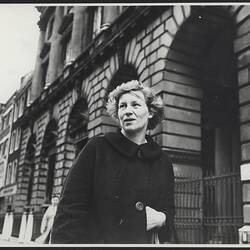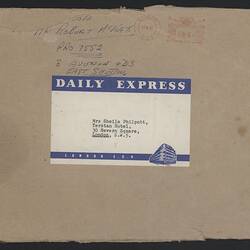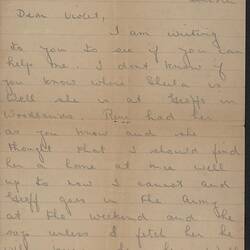Summary
Shelagh (formerly Sheila) Philpott (nee Bannister) spent nine years at Bramhope Children's home in England before being told her mother no longer lived and sent to Australia as a child migrant in 1950.
Early Life:
Sheila Lillian Bannister was born on 23 July 1934 in the district of Doncaster, England. Her mother was Margaret (Peggy) Bannister (nee Barker) of 18 Raymond Road Bentley, Doncaster, aged about 19 or 20 when she gave birth to Sheila. Peggy was working, and probably living in, as a domestic servant. Sheila's father was Luke (or Leslie) Houghton, aged about 23 at this time and in the RAF. Her mother did not give her father's name when she registered Sheila's birth seven days after she was born and apparently Sheila's parents were not married. Sheila attended Lovers' Lane Infant School in Newark and later Old Bramhope School. At this time she was living with a foster mother at 26 Middleton Road, Newark, Nottinghamshire. She may also have been cared for by various aunts or uncles, as the people where her mother lived and worked did 'not want children'.
Life at Bramhope, National Children's Home:
Sheila was six years old in 1940 when her mother, having not been able to find others who would take her, decided that 'the only thing left is to put her in a children's home' (from letter, 25 September 1940, Peggy Bannister to Violet Barker). In September 1941, after having been advised that her daughter was too old for adoption, Peggy wrote to the National Children's Home and Orphanage (NCH), 85 Highbury Park, London, enquiring about placing Sheila in one of their Homes. (from letter, 17 September 1941, Peggy Bannister to Secretary, NCH). An application was made to them in October 1941 and on 23 October 1941 Sheila moved to live at Bramhope, a branch of the NCH, near Leeds, in Yorkshire. Her father was paying 10 shillings a week in family support from his RAF pay and this was redirected to the NCH. At 84 years Sheila has no memories of her childhood before she went to live at Bramhope Home (from interview 1 Feb 2019, Sheila Philpott with Dr Moya McFadzean, Senior Curator, Migration & Cultural Diversity, Museums Victoria). About two years later, Peggy married Leonard (?) Sarjantson and they were living at 10 Parker Street, Newark-on-Trent, Nottinghamshire. She then sought to have Sheila return from the Home to live with she and her husband as 'her circumstances had changed considerably for the better' (from letter, 27 October 1943, Margaret Sarjantson to NCH). Sheila moved back in with her mother in December 1943. But after only three months her mother asked if Sheila could move back to Bramhope, as her daughter's life had been 'made a perfect misery' by her step-father and she couldn't 'prevent this very unfair treatment' (from letter, 2 March 1944, Margaret Sarjantson to NCH). So Sheila returned to Bramhope in April 1944. Sheila's mother applied to be separated from her husband at that time. Sheila then remained living at Bramhope in Leeds until she was 15. Internal NCH reports noted that her mother ceased being in touch and could not be traced, and that Sheila had no visits from friends or relatives and no outings for holidays. In 1948 Sheila had an operation for appendicitis and spent time in Leeds Infirmary. In 1949 she had left school and was working as a domestic in the Bramhope home.
Of her nine years at the National Children's Home from the ages of 7 to 15 Sheila remembers feeling she was completely at the mercy of 'those women' at Bramhope - 'your typical orphanage'. She reflects that 'blind obedience' was enforced by 'very strict discipline'. Children were punished for the smallest things, by having to sit in the cupboard under the stairs, being given extra scrubbing, reduced food and other children not being allowed to speak to them. At Bramhope there were four houses of 24 girls each and in a separate section, six buildings housing 25 boys. Each house had its own facilities and there was no interaction between the girls and boys (from interview 1 February 2019, Sheila Philpott with Moya McFadzean, as above).
Off to Australia:
In early 1949 Sheila wanted to discover where her mother was then living and the NCH attempted, unsuccessfully, to find out for her. Sheila today recalls being told her parents were dead. The NCH documents record that she would be leaving school in the summer of 1949 and had no wish to return to her mother's home 'wherever that it may be'. She apparently wished to become a 'Land Girl', that is, one of the women working on farms during wartime (from letter, 23 March 1949, R.G. Eaglestone, Governor Bramhope Branch to Rev Waterhouse, NCH, London). Sheila remembers one day being told she was wanted in the Governors' office and was very afraid. 'Bannister,' Sheila recalls him saying, 'we're sending you to Australia!' Sheila remembers feeling that she knew it would not have mattered if she didn't want to go. She had had no recent contact with her mother and only had a last address for her at 73 Winchester St, London, or 55 Buckingham Palace Road, S.W.1 which proved fruitless (from interview 1 February 2019, Sheila Philpott with Moya McFadzean, as above).
In September 1949, Sheila, then just over 15, lodged an application for an assisted passage to Australia - it is not known how this was initiated. She cited a Miss D. Ellwood, as a friend of hers living in Yarraville, Melbourne and that the NCH would make all arrangements. On 11 March 1950, Sheila, with a group of other Bramhope girls, embarked on the S.S. Asturias from Southampton to Australia. After a brief time in a hostel, Sheila was sent to work on a farm for a Mr H.A. Cameron at Pigeon Ponds, beyond Hamilton in the Western District of Victoria. She was not paid and the Camerons justified this by arguing they gave her board and lodging. 'You started slavery', as Sheila now describes it (from interview 1 February 2019, Sheila Philpott with Moya McFadzean, as above). She remembers the food was good but the work was hard. She was there until at least October 1951. She did not know she was entitled to wages and later the Home gave her forty pounds towards her owed earnings. By September 1952 Sheila was working as a live-in domestic looking after the three children of Dr and Mrs Barrett at 310 Wattletree Road, East Malvern, a southeast inner suburb of Melbourne. She worked for them for about two years until around November 1954.
Marriage & Family:
During this time she met Eric Philpott, the younger son of Mr and Mrs A.J. Philpott of Kew. Eric was a builder's apprentice. Despite resistance from Mrs Philpott, Sheila and Eric became engaged on 3 March 1954. Sheila wrote to NCH to let them know of her happy engagement for inclusion in their next issue of 'Our News'. She began calling herself 'Shelagh' around this time (from letter from Shelagh to Rev Litten, Principal of NCH, undated, but about March 1954]. Sheila and Eric were married on 22 January 1955. Dr Barrett gave her away at the marriage service. The couple subsequently lived at 12 Holroyd Street in Kew and were probably renting. Shelagh at this time played hockey for Melbourne Y.W.C.A. Shelagh and Eric had three sons, David Anthony (b.1956), Richard Bryan (b. 1959) and Peter John (b.1961). By 1961 they had moved to 82 Charles Street in Kew.
Pain of A Lost Past:
Shelagh became increasingly troubled by not knowing about her mother and father. She began to make enquiries and wrote to the NCH in England seeking any information they might have. In a reply she was told that her parents had not been married and this came as a shock to her. With the help of the NCH she placed a notice seeking her mother in the 'News of the World' (24 December 1961). Correspondence suggests she was also in contact with some of the other girls who came to Australia with her from the Home. Without any satisfaction from her attempts to find her mother, Shelagh became increasingly distraught over the next few years. She wrote again to the NCH in 1964 informing them she had had 'a very serious mental breakdown' earlier that year and that she was planning to leave her family and return to England to look for her parents (from letter, 23 November 1964, Shelagh to NCH). Reverend Gordon Barritt, then responsible for Aftercare at NCH, wrote to her several times and also contacted others in England and Australia to ask them to provide support.
Around August 1965, after selling personal items to raise funds, Shelagh obtained a passport, booked her passage, left her husband and sons and sailed to London. In mid-September she was staying at the Terstan Hotel, London and had been to Somerset House on her 'secret quest'. A reporter from the Daily Mirror met her and published her story ("Wife is on a secret quest for 'ghost' from the past", Daily Mirror, [?] September 1965). This apparently was successful in putting her in contact with family members and friends and by October Shelagh was staying with relatives in West Kensington, London. She had also found work as a waitress. During this period two Methodist Ministers in Melbourne, Reverend Keith Mathieson and Reverend Rule, were in contact with Shelagh's husband and family and also with NCH in London to provide updated information about her situation as they knew it. By mid-October Reverend Mathieson wrote that Shelagh had found her mother 'in a home for alcoholics' (letter 13 October 1965, Mathieson to NCH).
Shelagh returned to her family but has never recovered from the grief of the loss of her home, family and identity in England. Her husband Eric died in 2011.
Apology & Reparation:
In 2010 the UK Government made a formal apology to former British child migrants and established the Child Migrants Trust and its Family Restoration Fund. Sheila applied for recognition under this program and on 19 June 2019 a payment of £20,000 was made to her, being the full amount payable to eligible British child migrants for the hardship and distress suffered as a result of those historic child migration programmes (letter 19 June 2019, Dept of Health and Social Care, HM Government to Sheila Philpott).
More Information
-
Keywords
-
Authors
-
Article types
